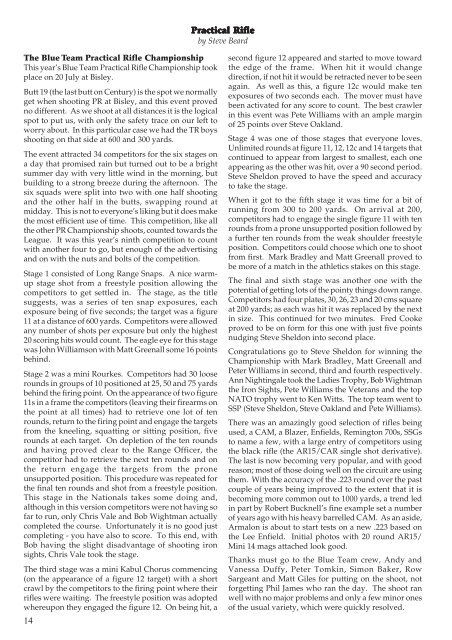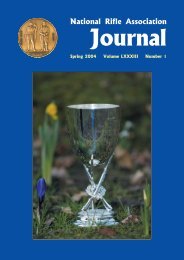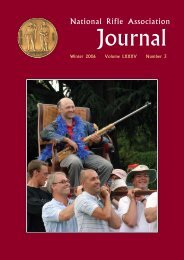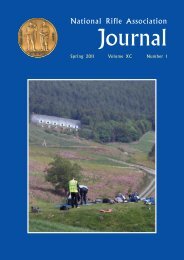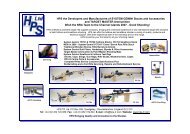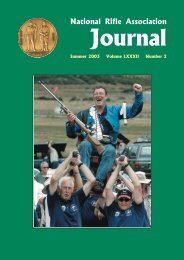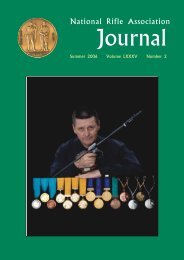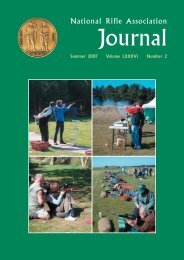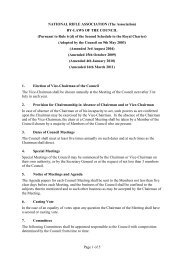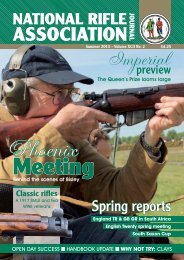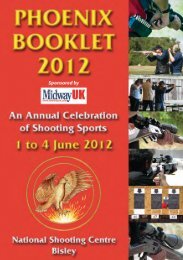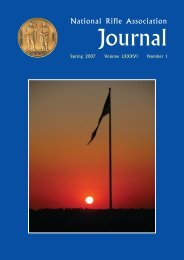Winter 2002 - National Rifle Association
Winter 2002 - National Rifle Association
Winter 2002 - National Rifle Association
- No tags were found...
Create successful ePaper yourself
Turn your PDF publications into a flip-book with our unique Google optimized e-Paper software.
Practical <strong>Rifle</strong>by Steve BeardThe Blue Team Practical <strong>Rifle</strong> ChampionshipThis year’s Blue Team Practical <strong>Rifle</strong> Championship tookplace on 20 July at Bisley.Butt 19 (the last butt on Century) is the spot we normallyget when shooting PR at Bisley, and this event provedno different. As we shoot at all distances it is the logicalspot to put us, with only the safety trace on our left toworry about. In this particular case we had the TR boysshooting on that side at 600 and 300 yards.The event attracted 34 competitors for the six stages ona day that promised rain but turned out to be a brightsummer day with very little wind in the morning, butbuilding to a strong breeze during the afternoon. Thesix squads were split into two with one half shootingand the other half in the butts, swapping round atmidday. This is not to everyone’s liking but it does makethe most efficient use of time. This competition, like allthe other PR Championship shoots, counted towards theLeague. It was this year’s ninth competition to countwith another four to go, but enough of the advertisingand on with the nuts and bolts of the competition.Stage 1 consisted of Long Range Snaps. A nice warmupstage shot from a freestyle position allowing thecompetitors to get settled in. The stage, as the titlesuggests, was a series of ten snap exposures, eachexposure being of five seconds; the target was a figure11 at a distance of 600 yards. Competitors were allowedany number of shots per exposure but only the highest20 scoring hits would count. The eagle eye for this stagewas John Williamson with Matt Greenall some 16 pointsbehind.Stage 2 was a mini Rourkes. Competitors had 30 looserounds in groups of 10 positioned at 25, 50 and 75 yardsbehind the firing point. On the appearance of two figure11s in a frame the competitors (leaving their firearms onthe point at all times) had to retrieve one lot of tenrounds, return to the firing point and engage the targetsfrom the kneeling, squatting or sitting position, fiverounds at each target. On depletion of the ten roundsand having proved clear to the Range Officer, thecompetitor had to retrieve the next ten rounds and onthe return engage the targets from the proneunsupported position. This procedure was repeated forthe final ten rounds and shot from a freestyle position.This stage in the <strong>National</strong>s takes some doing and,although in this version competitors were not having sofar to run, only Chris Vale and Bob Wightman actuallycompleted the course. Unfortunately it is no good justcompleting - you have also to score. To this end, withBob having the slight disadvantage of shooting ironsights, Chris Vale took the stage.The third stage was a mini Kabul Chorus commencing(on the appearance of a figure 12 target) with a shortcrawl by the competitors to the firing point where theirrifles were waiting. The freestyle position was adoptedwhereupon they engaged the figure 12. On being hit, a14second figure 12 appeared and started to move towardthe edge of the frame. When hit it would changedirection, if not hit it would be retracted never to be seenagain. As well as this, a figure 12c would make tenexposures of two seconds each. The mover must havebeen activated for any score to count. The best crawlerin this event was Pete Williams with an ample marginof 25 points over Steve Oakland.Stage 4 was one of those stages that everyone loves.Unlimited rounds at figure 11, 12, 12c and 14 targets thatcontinued to appear from largest to smallest, each oneappearing as the other was hit, over a 90 second period.Steve Sheldon proved to have the speed and accuracyto take the stage.When it got to the fifth stage it was time for a bit ofrunning from 300 to 200 yards. On arrival at 200,competitors had to engage the single figure 11 with tenrounds from a prone unsupported position followed bya further ten rounds from the weak shoulder freestyleposition. Competitors could choose which one to shootfrom first. Mark Bradley and Matt Greenall proved tobe more of a match in the athletics stakes on this stage.The final and sixth stage was another one with thepotential of getting lots of the pointy things down range.Competitors had four plates, 30, 26, 23 and 20 cms squareat 200 yards; as each was hit it was replaced by the nextin size. This continued for two minutes. Fred Cookeproved to be on form for this one with just five pointsnudging Steve Sheldon into second place.Congratulations go to Steve Sheldon for winning theChampionship with Mark Bradley, Matt Greenall andPeter Williams in second, third and fourth respectively.Ann Nightingale took the Ladies Trophy, Bob Wightmanthe Iron Sights, Pete Williams the Veterans and the topNATO trophy went to Ken Witts. The top team went toSSP (Steve Sheldon, Steve Oakland and Pete Williams).There was an amazingly good selection of rifles beingused, a CAM, a Blazer, Enfields, Remington 700s, SSGsto name a few, with a large entry of competitors usingthe black rifle (the AR15/CAR single shot derivative).The last is now becoming very popular, and with goodreason; most of those doing well on the circuit are usingthem. With the accuracy of the .223 round over the pastcouple of years being improved to the extent that it isbecoming more common out to 1000 yards, a trend ledin part by Robert Bucknell’s fine example set a numberof years ago with his heavy barrelled CAM. As an aside,Armalon is about to start tests on a new .223 based onthe Lee Enfield. Initial photos with 20 round AR15/Mini 14 mags attached look good.Thanks must go to the Blue Team crew, Andy andVanessa Duffy, Peter Tomkin, Simon Baker, RowSargeant and Matt Giles for putting on the shoot, notforgetting Phil James who ran the day. The shoot ranwell with no major problems and only a few minor onesof the usual variety, which were quickly resolved.


